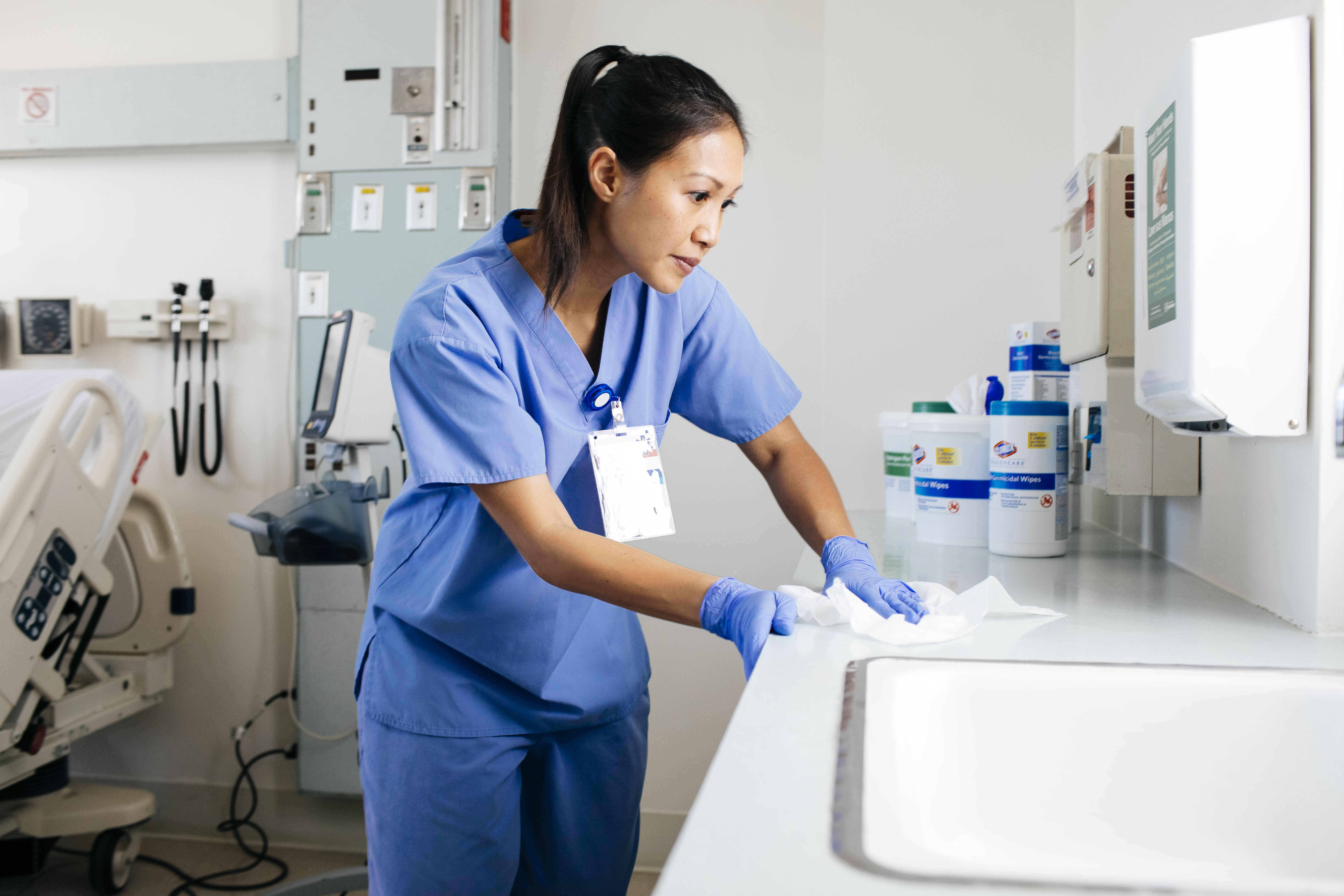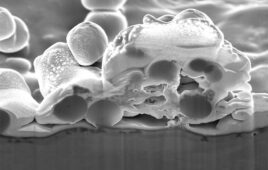Experts agree that thorough cleaning and disinfection of environmental surfaces are essential elements of effective infection prevention programs. However, despite the important role that environmental hygiene plays in patient safety, studies suggest that in practice, cleaning and disinfection is often suboptimal with healthcare workers treating only about 30 to 50 percent of the surfaces that they should be.
Many factors contribute to this gap between best practice and actual practice. Staffing and budget challenges are significant, as is increased pressure to cut down room turnaround times. There’s often also a failure to follow manufacturer’s recommendations for use or use of disinfectants with inadequate antimicrobial activity against healthcare-associated pathogens.
A 2016 review of modern technologies for improving cleaning and disinfection of environmental surfaces in hospitals, published in the journal Antimicrobial Resistance and Infection Control, concluded that “continued efforts to improve traditional manual disinfection of surfaces are needed.”
The way we see it, from a product perspective, there are two important avenues for improvement. Both rely on innovation.
The first approach is to develop new solutions — to rethink what is possible for surface disinfectants and explore novel ways to deliver the efficacy that healthcare facilities need while simultaneously addressing common concerns about compatibility and aesthetics.
The second tactic is to always strive for improvements ensuring the mainstay surface disinfectants used by hospitals and surgical centers around the country continue to meet the highest standards of efficacy and the needs of real-world healthcare environments.
Below are just a few of the ways that Clorox Healthcare is working to do both.
Rethinking Bleach
Many facilities, particularly those battling high rates of healthcare-associated Clostridium difficile (C. difficile) infection, have sought to expand the use of sporicidal disinfectants beyond patient isolation rooms to better address the role of the environment in pathogen transmission and acquisition.
Interest in expanded sporicidal use is also a trend in high-risk areas — such as intensive care units, pre-operative clinics, operating rooms, and post-operative care areas — where the potential cost of failures in environmental disinfection is very high, both financially and in terms of patient outcomes. The challenge facilities face is how to balance the potential benefits of expanded use of sporicidal disinfectants with the concerns sometimes associated with powerful disinfectant chemistries, including non-bleach sporicides.
Clorox Healthcare recognized this challenge, so our R&D team worked for years to create a new product that could address common concerns about surface compatibility and aesthetic issues without compromising efficacy.
The result of this work was Clorox Healthcare Fuzion Cleaner Disinfectant, a new product that combines the proven power of bleach with the aesthetics required for broad use throughout healthcare facilities. The powerful formula kills C. difficile spores in two minutes, the fastest kill time available, and 35 other pathogens in one minute, and is easy to use with no personal protective equipment (PPE) required.

(Image credit: Clorox Healthcare)
Fuzion uses a revolutionary technology to eliminate the chemical reaction that can damage surfaces and leave a residue. The formula is made up of sodium hypochlorite and a neutralizer solution. When the trigger spray is pulled, the neutralizer combines with the sodium hypochlorite, converting it into hypochlorous acid, a highly effective form of bleach, as it is sprayed on the surface.
Once the contact time is reached, the neutralizer breaks down the bleach solution so that only water and a small amount of salt remain, leaving essentially no residue on the surface. Fuzion’s unique method of action makes it practical for everyday use across a wide variety of surfaces, eliminating concerns about damage or costly replacements, while maintaining a very low odor profile.
Innovating to Protect Against Healthcare Pathogens and Emerging Threats
In the fight against healthcare-acquired infections (HAIs), today’s healthcare facilities need proven solutions to kill a broad range of infection-causing pathogens, from deadly hospital pathogens like C. difficile to new threats posed by emerging viral pathogens.
Every facility is different, so beyond the development of new products, we believe it’s important to address evolving challenges from a broader portfolio perspective. Clorox Healthcare voluntarily tested two of its leading ready-to-use bleach disinfectants, Clorox Healthcare Bleach Germicidal Wipes and Clorox Healthcare Bleach Germicidal Cleaners, using updated U.S. Environmental Protection Agency (EPA) recommended standards, which raise the bar for sporicidal disinfectant efficacy. As a result, both products are now EPA-registered to kill C. difficile spores in three minutes, tested in the presence of a three-part organic soil load.
Evidence suggests that the pre-cleaning step required for disinfection against C. difficile spores is often missed. The updated EPA recommended standards includes guidance for testing disinfection against C. difficile spores in the presence of soil, a more challenging yet realistic scenario. In practice, the pre-cleaning step is still required, but any product that has passed this test offers users an extra level of assurance that the product will not fail if soil is present.

(Image credit: Clorox Healthcare)
Clorox Healthcare Bleach Germicidal products have also gained new disinfection claims for emerging viral pathogens including SARS-associated Coronavirus (SARS-CoV), Middle East Respiratory Syndrome-associated Coronavirus (MERS-CoV), and other recent HAI threats.
In an increasingly global and interconnected society, emerging and re-emerging infectious diseases are often only a plane ride away. This means that while hospitals and surgical facilities continue to contend with familiar threats like C. difficile, they also need to be prepared for whatever comes through their doors next. And they need to know that their disinfectants are up to the task.
Looking Ahead
From physician offices to acute care facilities and the ambulatory surgery centers transforming the outpatient experience, how and where care is delivered is changing. And it’s changing in ways that impact infection prevention and control.
To confront these changes, facility and health system leaders, healthcare providers, researchers, and manufacturers all need to take a hard look at the realities of today’s healthcare environments and think ahead to anticipate the challenges to come.
Our goal at Clorox Healthcare is ambitious: to remove the environment from the infection prevention equation. It won’t be easy and it won’t happen overnight, but our approach is built on the understanding that the healthcare environment is not static. In fact, it’s evolving every day.
It’s critical to pay close attention to the health policy landscape as well as the science that informs best practices. It requires examination of growing antibiotic resistance and the pathogens that pose the greatest threat.
We believe that in this fast-paced environment, the surface disinfectants healthcare facilities rely on must evolve too.
Laurie Rabens is a Senior Product Manager with Clorox Healthcare. She has 10 years of marketing experience in healthcare, including medical products, devices, and pharmaceuticals. She holds a B.A. from the University of Pennsylvania and an MBA from the UCLA Anderson School of Management.




